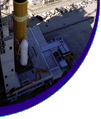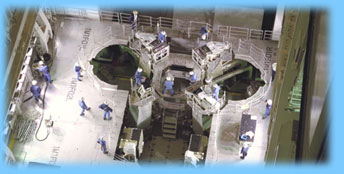 |
 |
 |

|
 Jiro Kochiyama Jiro Kochiyama
Project Manager,
H-IIA Launch Vehicle Project Team,
Japan Aerospace Exploration Agency
JAXA found that the SRB-A solid rocket booster was the trigger
of the H-IIA F6 accident. This led to a complete overhaul of the rocket. All
the H-IIA Launch Vehicles
were thoroughly inspected, resulting in greatly improved reliability. We are
now keen to build a rocket that is lower in cost but has enhanced functions
and reliability.
I think we now need to move from judging technology based
solely on past experience, to the next level - technology proven through rigorous
scientific testing. In this regard, I am already seeing some changes in the organization:
efforts to be more objective and to question the assumptions of the past, as
we move toward the birth of new technology.
Also, "improving reliability" requires
relentless effort. Once you have done all that you possibly can in applying all
your skill and knowledge, what happens beyond that is out of your hands. Therefore,
I remind myself that the most important thing is to make the utmost efforts during
the process.
The process we went through - the thorough inspection and evaluation
of our existing technologies - did a lot to raise awareness of reliability issues.
|
The next steps will involve reviewing what has been done,
then systematizing, honing and stabilizing the technology and procedures. One
successful rocket launch
provides valuable data on the mechanics of the launch, and successful repetition
leads to future development of reusable launch vehicles, and to manned flight.
If we launched a non-reusable rocket without ensuring the collection of a full
range of technical data and a thorough examination of all related phenomena,
all the effort put into the launch would be thrown away with the rocket itself.
As we already have a lot of data on the H-IIA Launch Vehicle, it is very important
now to improve reliability and perfect the technology for the future.
"Meet
in front of the VAB-2 [the Vehicle Assembly Building-2]." This is our slogan.
After a successful launch, everyone who has been involved with the rocket gathers
in front of the VAB-2, and drinks to its success and to all our efforts. Meeting
in front of VAB-2 once more, after working so hard on the rocket, is our goal.
|

The conditions for the resumption of rocket launches have almost all been met. Since
the H-IIA F6 accident, under a very tight schedule, we have been working very
hard on investigating the cause and meeting the conditions for the next launch.
Now it is up to us to maintain the same momentum for the operation at the Tanegashima
Space Center, where the new rocket will be launched. I would like to ensure
that my team is in good health and at full mental capacity on the day of the
launch.
|
|
 |
 |

